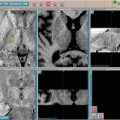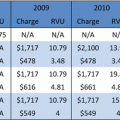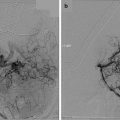Histologic types
No. with spine seeding/total no. of patients (%)
1. Mature and immature teratoma
0/20 (0 %)
2. Mixed NGGCT
1/26 (4 %)a
3. Other NGGCT
0/11 (0 %)
4. Germinoma
2/48 (4 %)b
5. Pineocytoma
0/9 (0 %)
6. Pineoblastoma, PPTID, mixed PPT
4/21 (19 %)c
Total
7/135 (5 %)
One hundred patients underwent radiotherapy (Table 36.2). Regions treated included the craniospinal axis in 35 patients, the whole brain in 26 patients, and the partial brain in the remaining 39 patients. Doses delivered to the primary tumor bed ranged from 4,500 to 6,480 cGy (median dose, 4,132 cGy) in 150- to 200-cGy fractions. Eleven patients treated during the earlier years of this study received total doses of less than 3,000 cGy. When treated, the whole brain received 2,000–5,040 cGy and the spine received 2,000–3,800 cGy. Chemotherapy was administered to 35 patients as a component of initial therapy (Table 36.2). These patients received various combinations of the following agents: BCNU, CCNU, cyclophosphamide, prednisone, vincristine, vinblastine, cisplatin, etoposide, dactinomycin, bleomycin, chlorambucil, thiotepa, procarbazine, and melphalan.
Table 36.2
Summary of therapya
Histologic type | Therapy | |||
|---|---|---|---|---|
RT | No RT | Chemotherapy | No chemotherapy | |
1. Mature teratoma | 2 | 5 | 1 | 6 |
2. Immature teratoma | 2 | 7 | 0 | 9 |
3. Mixed NGGCT | 19 | 6 | 17 | 8 |
4. Other pure NGGCT | 5 | 4 | 3 | 6 |
5. Germinoma | 48 | 0 | 8 | 40 |
6. Pineocytoma | 6 | 1 | 0 | 7 |
7. PB, PPTID, mixed PPT | 18 | 0 | 6 | 12 |
Histologic type | Surgical procedure | |||
Biopsy | Subtotal resection | Gross total resection | ||
1. Mature teratoma | 0 | 3 | 4 | |
2. Immature teratoma | 3 | 2 | 4 | |
3. Mixed NGGCT | 3 | 12 | 10 | |
4. Other pure NGGCT | 4 | 3 | 2 | |
5. Germinoma | 29 | 16 | 3 | |
6. Pineocytoma | 3 | 4 | 0 | |
7. PB, PPTID, mixed PPT | 9 | 6 | 3 | |
Patients were followed for 0.25–37.3 years or until death (median follow-up, 5.3 years). The survival rate for the entire group of patients was 62 % at 5 years. Survival was worse for patients treated during the early years of this study. Patients diagnosed before 1973 had a 5-year survival rate of 34 % compared with 66 % for those patients diagnosed more recently (p = 0.0002). Twelve of the patients who were operated on between 1936 and 1950 died in the immediate postoperative period. These patients were excluded from the remainder of the analysis because their deaths were more likely a result of operative complications than of progressive disease.
Tumor histology was evaluated for its relationship to survival. The 5-year patient survival rate was 86 % for those with mature teratomas, 86 % with pineocytomas, 80 % with germinomas, 67 % with immature teratomas, 49 % with PPTs other than pineocytomas (PB, PPTIDs, and mixed PPTs), 38 % with mixed GCTs, and 17 % with the other pure NGGCTs (p = 0.0001). Age, sex, and tumor location were not associated with survival.
The extent of resection was evaluated for its effect on patient survival. NGGCTs were the only tumors for which survival was associated with extent of tumor resection. The 3-year survival rate was 0 for patients having a biopsy, 36 % for patients having a subtotal resection, and 73 % for patients having a gross total resection (p = 0.0002).
The relationship between the administration of chemotherapy (as a component of initial therapy) and survival was evaluated. Patients who received chemotherapy had a 5-year survival rate of 45 % compared with 65 % for those patients who did not (p = 0.37). However, the administration of chemotherapy was associated with improved survival rates in patients with NGGCTs other than mature and immature teratomas. Patients with NGGCTs who received chemotherapy had a 3-year survival rate of 56 % compared with 8 % for patients who did not receive chemotherapy (p = 0.0001).
Most of the patients (100 of 123) received radiotherapy. However, only four patients with either mature or immature teratomas received radiotherapy. Therefore, the effect of radiotherapy in patients with mature and immature teratomas could not be assessed. Patients with NGGCTs, other than mature and immature teratomas, who received radiotherapy had a 3-year survival rate of 46 % compared with 11 % for patients who received no radiotherapy (p = 0.0089). There was an association between the dose of radiation administered and survival in patients with NGGCTs other than mature and immature teratomas. Patients who received ≤5,000 cGy had a 3-year survival rate of 21 % compared with 55 % for patients receiving higher doses (p = 0.02). The dose of radiation administered correlated with survival rates in patients with PPTs. Patients with PPTs receiving doses of ≤5,000 cGy had a 3-year survival rate of 56 %, and patients who received higher doses had a 3-year survival rate of 94 % (p = 0.03). There was also an association between the dose of radiation administered and survival in patients with germinomas. Those patients with germinomas receiving doses of ≤4,400 cGy had a 5-year survival rate of 70 % compared with 92 % for patients who received higher doses (p = 0.04). There was no association between patient survival and radiation field arrangement (partial-brain irradiation, whole-brain irradiation, or craniospinal axis irradiation).
Spinal seeding was the predominant pattern of distant failure. The outcome for patients with evidence of spinal seeding at the time of diagnosis is summarized in the footnotes of Table 36.1. The risk of spinal failure relative to both tumor type and radiotherapy field arrangement for patients without evidence of spinal seeding at diagnosis is shown in Table 36.3. Patients with PPTs (other than pineocytomas) and GCTs (other than mature and immature teratomas) had the greatest risk of spinal failure.
Table 36.3
Probability of spinal failure in patients without evidence of spinal seeding at diagnosis
Histologic types | No. with spine failure/total no. of patients (%)a | |||
|---|---|---|---|---|
1. Mature and immature teratoma | 0/16 (0 %) | |||
2. Mixed NGGCTb | 1/24 (4 %) | |||
3. Other NGGCTb | 3/9 (33 %) | |||
4. Germinoma | 8/46 (17 %) | |||
5. Pineocytoma | 0/7 (0 %) | |||
6. Pineoblastoma, PPTID, mixed PPT | 8/14 (57 %) | |||
Total | 20/116 (17 %) | |||
Probability of spinal failure according to the radiotherapy fields in patients without evidence of spinal seeding at diagnosisc (including only seeding malignancies) (%) | ||||
Histologic types | PB | WB | CSPRT | Total |
1. NGGCTd | 2/4 (50 %) | 0/8 (0 %) | 1/11 (9 %) | 3/23 (13 %) |
2. Germinoma | 7/25 (28 %) | 1/11 (9 %) | 0/10 (0 %) | 8/46 (17 %) |
3. PPTe | 2/3 (66 %) | 2/5 (40 %) | 4/6 (66 %) | 8/14 (57 %) |
Total | 11/32 (34 %) | 3/24 (13 %) | 5/27 (19 %) | 19/83 (23 %) |
Only one patient developed distant metastases outside the central nervous system. This individual had a mixed GCT with a component of malignant teratoma. After placement of a ventriculo-peritoneal shunt for the treatment of tumor-induced hydrocephalus, he developed peritoneal metastases and died.
Conclusion
Pineal region tumors are rare and include a large variety of lesions. Many studies included patients whose tumor types were not histologically verified because of the risks associated with operative intervention [10, 11, 16–18]. As a result, these series may have included patients with benign processes such as cysts and vascular lesions. Prognosis is clearly dependent upon tumor histology. This finding has been reported by many investigators [19–32], with patients with pineocytomas, germinomas, and mature teratomas demonstrating the most favorable survival rates.
Jennings et al. found that survival was dependent upon the extent of tumor, which emphasizes the importance of careful staging [25]. The staging workup should include a careful history and physical examination, MRI of the brain and spine, spinal fluid cytology, complete blood cell count, chemistry panel, baseline ophthalmologic exam, and tumor marker studies (AFP and β[beta]-HCG from both the CSF and serum). Caution should be exercised when obtaining CSF from patients with increased intracranial pressure, because herniation of the brain may occur if pressure is rapidly reduced.
The treatment of pineal and other primary CNS GCTs requires a precise knowledge of tumor histology. Obtaining a histologic diagnosis is important because optimal therapy for the various tumor types differs significantly. Improvements in surgical technique and postoperative care have decreased the morbidity once associated with resection or biopsy of these tumors. Popovic and Kelly reported on 34 patients with pineal lesions who underwent 66 stereotactic procedures at the Mayo Clinic (including 37 biopsies and 10 resections) [15]. Diagnostic tissue was obtained in 33 of the 34 patients. No mortality or permanent morbidity was observed. Because the survival of patients with NGGCTs appears dependent upon the extent of resection, total resection should be attempted in all cases where it can be safely performed. Obtaining tissue for diagnosis is recommended in all patients with pineal region tumors whenever possible.
Platinum-based multiagent chemotherapy has dramatically improved the outcome in patients with NGGCTs [11]. Our series revealed that a significant increase in survival was associated with the administration of chemotherapy to patients with NGGCTs other than mature and immature teratomas. Many other authors have recommended the use of platinum-based multiagent chemotherapy for the treatment of NGGCTs of the brain [20, 21, 25, 26, 32–36].
Stay updated, free articles. Join our Telegram channel

Full access? Get Clinical Tree








